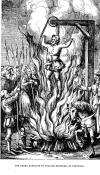|
Burning at the stake
Both Catholics and
Protestants had their martyrs but execution by burning at
the stake was a punishment normally inflicted for heresy
and witchcraft. The method was first approved for use
against heretics by the Synod of Verona in 1184 and
subsequently confirmed by the Lateran Council of 1215 and
the Synod of Toulouse in 1229.
In 1401
King Henry IV authorised the first actual statute in English law against heresy –
De Heretico
Comburendo, (Henry IV,c.15)
which gave the clergy power to arrest and
try those suspected of heresy. The Act condemned “divers false and perverse people of a new sect; they make unlawful conventicles, they hold and exercise schools, and make and write books.” By this Act, the lives of the subjects were put under the control of the bishops, who got power to fine and imprison all heretics, and all possessors of heretical books, while obstinate and lapsed heretics were handed over to the sheriff, to be burned at once, ‘in a high place before the people, that they might take salutary warning.’ The Act bears the title—‘The Orthodoxy of the Faith of the Church of England asserted, and provision made against oppugners of the same, with the punishment of hereticks.’ Penalties had been inflicted on heretics previously but the punishment was only occasional, and often the civil law intervened. But, now, a simple decree of a bishop sufficed to send a man
or woman to the stake. The accusation of heresy became sufficiently elastic to bring within it a considerable variety of offenders
for simply being different or daring to think for themselves.
The Act was aimed at the Lollards who were gaining popularity and in 1401 one of
their number, William Sawtrey, originally from Kings Lynn, Norfolk, was tied to the
stake and burnt on the direct order of the king.
The statute was repealed in 1553, but in
1555 three acts against heretics were revived one from
1194 in Richard II reign; one from Henry IV and one from
1416 in Henry V reign. Burning was re-introduced by Henry
VIII but it was his daughter, the Catholic Mary Tudor
(“Bloody Mary”), who took it to an excess with 274
burnings of both sexes for heresy during her five
year reign of terror. In most cases their only “crime” was
following the Protestant faith, but then even saying a
prayer that reflected against Mary Tudor was treason and death.
In Scotland there were the
burning of a number of Protestant believers as far back as
James Resby, a follower of John Wickliffe in 1407. Resby
challenged the Pope`s claim to rule Christendom as the
Vicar of Christ and insisted on personal holiness as a
condition of Papal office. In 1433 Paul Craw, or Crawar, a
Bohemian physician, was burnt at St Andrews. McCrie
in Sketches of Church History tells of 30
persons of gentility who were accused of heretical
sympathies in 1494 but were let off with an admonishment
when they, through having had an education, argued against
their accusers. There were others of nobility and
education who were not so fortunate notably Patrick
Hamilton (28 February 1527), George Wishart (1 March
1546), and Walter Mill (28 April 1558). In the seventeenth
century there were far more burnings for witchcraft (over
a thousand – some eighty per cent of these were women)
than for heresy.
The method of execution is
graphically described in The Scots Worthies and was
often accompanied by awe inspiring declarations of
innocence, faith and courage. But not all died the same
way. The common witch was piled about with faggots and
bound to the stake, she was then normally strangled to death before burning. Only in the worst cases was the
 cause cause
of death a combination of carbon monoxide
poisoning produced by the fire, and a period of excruciating pain from the flames and
heat. In 1552 William Gardiner was executed while in
Portugal where he was trussed up and lowered into the
flames – an especially slow and painful death. The
Scottish martyrs were possibly better treated in that
their death was aided by tying bags of gunpowder to the
body and a cord tied round the neck. The cord about the
neck was originally intended, by Catholic doctrine, to
throttle the prisoner before burning
but it seemed to become more of a means of shutting off
the the dying words and perhaps the screams of burning.
Whether it was also deliberately used as an aid to death is
uncertain (they were cruel times and suffering and death
was the objective), but drawn tightly by the executioner
as the flames gathered force it would have contributed to
asphyxiation.
It is illustrative of the
times and the malice of the clergy that they would go to
extreme lengths to get their way.
Patrick Hamilton was
related to King James V of Scotland and had a very eminent lineage.
He wrote a fulsome work which he called “Patrick`s Places”
in which he defended Protestant views and listed some
fifteen `Errors and Absurdities of the Papists`. His
forthright views made him a target for the priests and he
was eventually declared a heretic and burnt at the stake.
His lineage was of little help to him once the Church had
their grips on him.
|